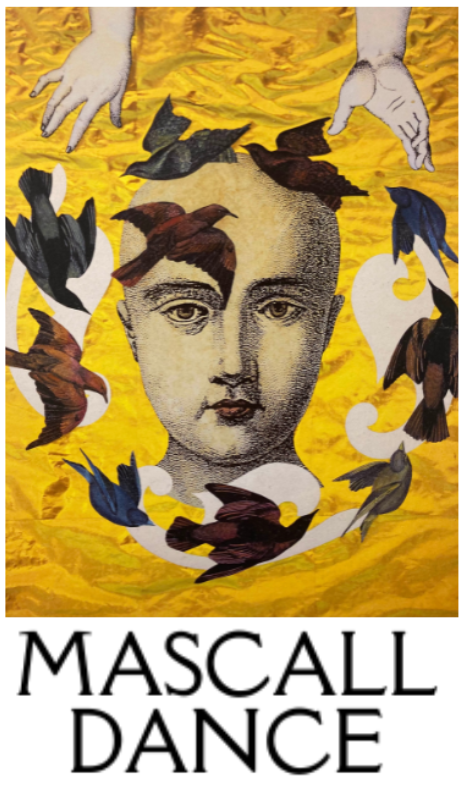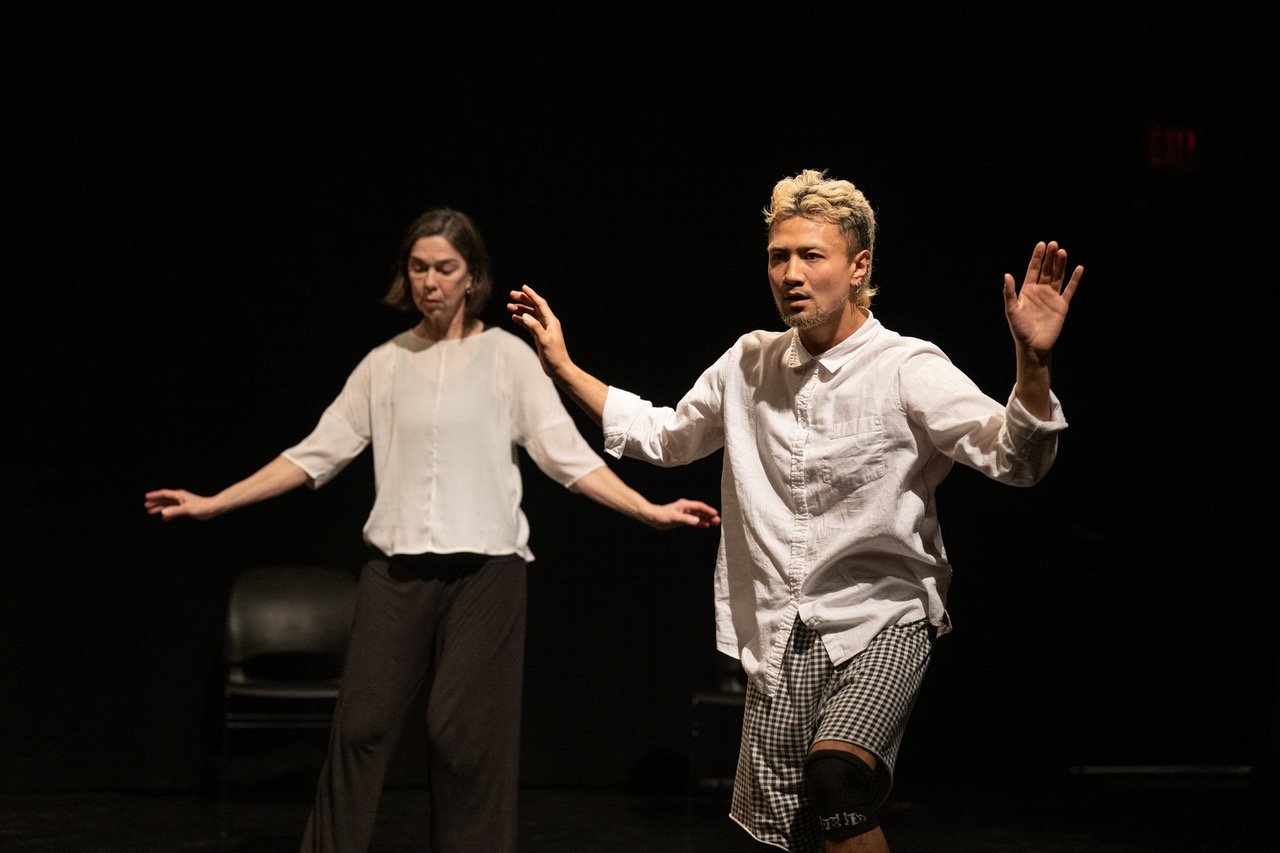LESLEY TELFORD IN RESIDENCE
S Tell us about your BLOOM residency.
L I’ve been working on an intergenerational project. We just did a showing last week. In BLOOM I’m pulling some of these ideas forward and shifting focus from 5 people to a duet for Daria Mikhaylyuk and Justin Calverados . They are extraordinary. It’s such a gift to work with them and I’m so pleased they were available for this. Let's see what it turns into.
S Fill us in a bit more?
L Well, I’d been looking at female Shakespearian characters and I started working with some professional dancers. We looked at Ophelia, who is actually a weak character, and through her, at strength and vulnerability - as individuals, and then connected with others. We were creating little tableaus of what one person chooses to do, and then how another person is going to help or hinder that. In a family, everyone doesn’t go down at once. There's always someone propping up the tent. I’ve been interested in this for a while.
I’d made a piece for Ballet BC called Lean-to examining interdependence; images of how you might lean on one, and then it tilts, and you lean on another, emerged, and I felt those moments very deeply in my own life. Back when I moved to Vancouver - a single mom, trying to be an artist - I leaned hard on my mother. She helped so much, babysat, was there. And over time, things shift. Now she needs us a little bit more, and my daughter is helping us so much. We're on this little teeter-totter of interdependence. So that's what it ended up being about. And it was so beautiful. I felt I really wanted to dedicate some time to this.
It’s interesting - I find the intergenerational project (we don’t have a title yet) to be one of the least stressful and most moving creations I've been part of.
Foreground: Daria Mkhayluk, Justin Calvadores and ensemble in recent showing of Telford multigenerational work-in-progress.
Photo Credit: David Cooper
S Why, do you think?
L Because it didn’t aim for any sort of accomplishment - it aimed for listening. Afterward, everyone talked about how you slow down enough to listen and care for everyone in this space. It’s quite magical. Along the way, there were often reminders to be aware, not assume or underestimate. One of the older dancers, a woman, said, “Well, I can run too.” She said, “Let me carry somebody.” And so we used those strengths too, and they brought so much.
Funny, I'm doing a piece for Vancouver Youth Choir. They say “We can’t move so fast. We need to do less.” I’ve heard “do less” for years, but now I'm having the real time experience of trying to do less. I feel I'm the choreographer, I have to do my job, I have to do my work, I have to do more movement, more action, more ideas. Do less.
S What about sound?
L Oh! I have so much music that it’s about paring down during BLOOM. In particular here’s a Carolyn Shaw) piece I find connects with these materials.
S Tell me a dance that changed you.
Daria Mkhayluk and ensemble in recent showing of Telford multigenerational work-in-progress.
Photo Credit: David Cooper
L Honestly, I often feel that every weighted, meaty, life-changing moment I’ve had was in Jiří Kylián’s work. He's got this inner poetry beauty that you really live through. He has that really dramatic sense. It feels like you can stop time - that you can really live in this swollen moment.
I was in the creation of this one particular piece that we did called Last Touch that was in this slow, slow motion. I remember he dressed us in long, heavy, elaborate period clothing. (Here’s me thinking ‘oh NO, I’m doing this Kylián creation and we’re NOT DANCING!”). It was hyper-slow motion. You’d reach for a candle so slowly that you couldn’t tell we were moving. There were 6 of us, each with our stories going on, and under us a huge canvas, a painter sheet slowly being pulled, so the ground was shifting underneath our feet. There were tables, chairs, candles, relationships that shifted with micro glances. For half an hour it built to face the front and then finally, there was the flash of a camera. And it was beautiful.
It changed what I thought dance could be. After the performance I remember speaking to Kylián and he was so happy, completely elated that the audience boo’d. He said “That’s the first time I was booed in my life! Everyone always cheers me on.” For me there was something about being part of his little experiment, to go “we’re going to just almost not move with this”. He has so many possibilities up his sleeve - and he didn't use them.
Intergenerational Project Photo David Cooper
This brings me back to your earlier question. I think the process was not stressful in this case because from the very beginning I’d relinquished control. Making sure things happen stresses me very much in professional situations. Here I’d given the control over to them from the very first day, because that’s the only way to work in that group. Left, right and centre, they and their improvisations, surprised me. I was an external eye, a bit like a photographer, seeing what happened, collecting what emerged, a very different role than micromanaging every detail.
S How to transpose this into a process with two professional dancers?
L Now, this is my big question, and maybe my challenge over the next little while. Because it's all about the culture you've built up: how you're used to creating, how people created with you, how (and if) trust is built. We're all showing up to something that feels expected of us. This is so good, to have this chat now, before we kind of veer into what we're going to do!
S Will you try to stay in that new role?
L It would be nice. I really like that external place, curator of the things that happen. It’s different but a close sister to the roles that we know.
S There’s that continuum between the known and the unknown in choreography, a running tension between intuition and premature decisions, needing to decide things before you know.
L Throwing yourself into a room full of expectation. My next project, I’m going to work with the Royal Winnipeg Ballet School, where you have to change gears and bring in a seed of something prepared? Yes, I think I'm really an unprepared person because I love responding to like, what I feel is going on in the room and. I love the tension of not knowing, the adventure of it. Not that I don’t prepare., I have ideas written down and constantly growing in my thoughts.
But I'm bringing up Kylián again -obviously a big influence - such a mentor of sorts. In an interview I heard him say he knew everything when he was outside the door. Then he knew 50% when he was at the threshold of the door. And then by the time he sat down, he knew nothing of what was going to happen.
S What would you like people to know?
L I’d like people to know that we did something really special this week and I want to continue that. I want to continue working in this. It was such a good lesson to work with professionals, non-professionals of vastly different ages. There was a 50-year gap between youngest and eldest, which was fantastic.
Daria Mikhaylyuk Photo: David Cooper
S Will you approach corporations for sponsorships to continue the project longterm?
L I'm looking to find someone to help me out with that; I’m terrible at it. But this project differs from situations where I have to convince people that I am a good choreographer. Instead, it's really something I can identify with; I know what I’m taking about and I can say “This has value because” of this, and this. It still feels like artwork, not community work, but it touches on both.
Over the past three years I've become kind of an advocate for seniors, during COVID, doing a lot of work in that direction. I've really fought the long-term care facilities like crazy, campaigned to government, and so forth. I began fighting so hard that my fighting was disturbing my mother. And then I realized this is the wrong way to fight. Instead, I came to see, let's highlight the value of exchanges across generations. It’s something I miss from living in Spain. There, people would party together, teenagers and grandparents. And we don't. We're segmented from this group to this group to this group. Segmented across generations, we don’t see what’s going on in care homes. We don't see demographics we're not a part of.
I've done pieces about this with younger people, but then I think - is this relevant to them? What is an aspect of something that they're going through that can relate to something that can relate to these ideas? So that's been a big question as well.
I made a piece a while back called Gem-like that I’d love to bring back. I was looking for those little magical moments. Because we didn't have time with my mom, I was looking for where is that little gem of time or these little moments that you treasure? The piece used very impersonal text from Fraser Health; we tried to make it feel personal. We tried to erase words to make it sound human.
I've been talking about my mother a lot. She used to work in the care facility she's in now and her motto was hugs, not drugs. She has been somebody fighting for humanity. And so now I need to fight for humanity for her, and that’s just how it should be. This intergenerational project is a way I’m seeking to bring this all together. My way of building a community I want to be a part of. I think my biggest goal was something that feels positive for everyone involved. Not driven, harder, faster, which has been part of my professional world for my whole life.
S It's always a pleasure, Leslie. Looking forward to seeing what emerges in BLOOM!









